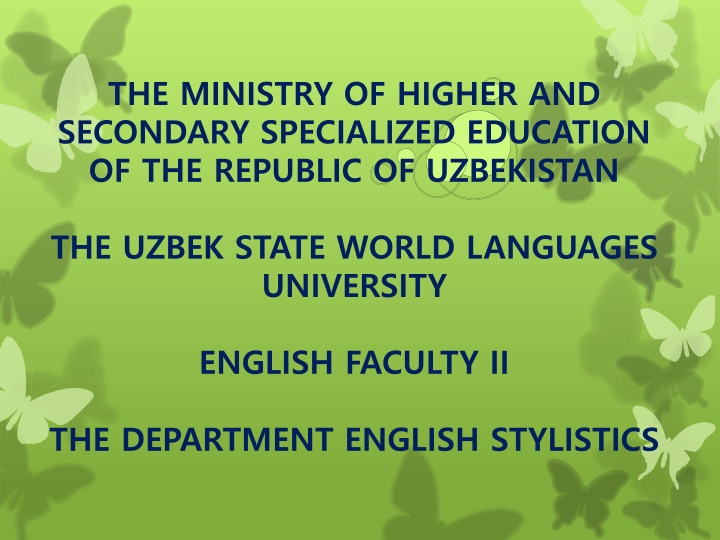
Cognitive Stylistics Analysis in Literary Texts at Uzbek State World Languages University
Delve into the world of cognitive stylistics analysis of literary texts through a qualification paper conducted at the Uzbek State World Languages University. Explore topics such as linguo-cognitive interpretation, the cognitive principle of foregrounding, and the convergence of stylistic devices. Discover the novelty and significance of this work within the context of modern style and linguistic trends.
Download Presentation

Please find below an Image/Link to download the presentation.
The content on the website is provided AS IS for your information and personal use only. It may not be sold, licensed, or shared on other websites without obtaining consent from the author. If you encounter any issues during the download, it is possible that the publisher has removed the file from their server.
You are allowed to download the files provided on this website for personal or commercial use, subject to the condition that they are used lawfully. All files are the property of their respective owners.
The content on the website is provided AS IS for your information and personal use only. It may not be sold, licensed, or shared on other websites without obtaining consent from the author.
E N D
Presentation Transcript
THE MINISTRY OF HIGHER AND SECONDARY SPECIALIZED EDUCATION OF THE REPUBLIC OF UZBEKISTAN THE UZBEK STATE WORLD LANGUAGES UNIVERSITY ENGLISH FACULTY II THE DEPARTMENT ENGLISH STYLISTICS
COGNITIVE STYLISTICS ANALYSIS OF LITERARY TEXT QUALIFICATION PAPER Student: Xodjayeva Gulhayo Scientific Advisor: Ph.D. N.Z.Normurodova
Chapter II Linguo cognitive interpretation of literary text Chapter III Cognitive principle of foregrounding as a stylistic value of perception and interpretation in English and Uzbek literary texts Chapter I Theoretical research on investigation 1.1. New perspective directions in antropothentric paradigm 1.1.1. Communicative stylistics and pragmatic linguistics 1.1.2. Cognitive aspects of stylistics 1.2. Text categories: theoretical and practical assumption 1.3. Literary text in the light of modern trends in linguistics 3.1. Convergence of stylistic devices and as an indicator of implicit meaning 3.2. Contrast as a cognitive principle in decoding stylistics 2.1. Emotiveness as a means of implicitness 2.2. Intertextuality as a main signal of conceptualization
The topicality is determined insufficient knowledge convergence of stylistic devices, the defeated expectancy, coupling as a means of foregrounding in the literary text, as well as the fact that the study of cognitive significance stylistically marked units and their role in a literary text is one of the urgent problems of modern style.
The novelty of the work is determined by the cognitive approach to the problem of conceptual analysis and interpretation of literary text.
The subject of research The object of research the convergence of stylistic devices, defeated expectancy, coupling and contrast, intertextuality as means of foregrounding in the literary text. stylistic and cognitive functions of cognitive categories in the literary text
1.1 The main new trends in linguistics Social linguistics Cognitive linguistics Linguoculturology Pragmatics
cohesion integrity informativity obligatory
the authors image subjective modality implicitness optional
stylistically marked units : emotively marked lexicon, word-formation means, neologisms, caressing words, zoonisms, somatisms expressive means in a form of dimunitiveness the poetic detail: Depicting detail; Characterogecial detail Auhenticity detail; The details of implicitness; Emotivness culturally marked units realiae. national context, speech etiquette, concepts stylistic categories, such as implicitness, image structure of literary text
Integrations O! Alas! Hey Exclamatory words Good! Well, Hear, etc. Emotive meaning Oaths and swear words The devil, Christ, God etc. Qualitative and intensifying adjectives and adverbs Awfully, terrible, fine, fantastic Nominal meaning Treated as proper noun It is spelt by a capital letter, e.g. Long fellow, Black Sea, Smith have nominal meanings It will always be secondary to the target meaning
2.2. Intertextuality as a main signal of conceptualization Wise Magi Della and Jim Innocence True love Loyalty Oblation Offering Tribute Devotion Dedication Sacrifice Adore Love Generosity Donation Gift Respect
3.1. Convergence of stylistic devices and as an indicator of implicit meaning Wonder of wonder Princes Sunlight BEAUTY Spring time Genius Reflection of the moon in the dark waters
Stage Lesson Teacher Birth and death Music Art Money Life Child Phrase Book Nature Pain Time Grape fruit Game
3.2. Contrast as a cognitive principle in decoding stylistics One of the main tasks of the research is to consider contrast as one of the cognitive principles of distributing information in the text. Contrast is considered from different points of view : philosophy, logic, linguistics, etc. In general, contrast is understood as: confrontation of two semantically and stylistically opposed language patterns.
The pre-last line includes the intertextual feature by using the hero Go ro g li from Uzbek dostons into this poem. Quvnoq,-Shirin so z, Shod, Xushchaqchaq, - Yuzi yorug , - Ulfat, - So zamon,- Ko ngli ochiq -Faqir, -Miskin, -Bechora, - Notavon, -Gado, - Kambag al, - Nochor,-Qo li qisqa, -Yetim,- Homiysiz odamzod G amgin Conceptual antonyms -Urush, - To polon, - Janjal, -Kurash, - Tortishuv, - Kelishmovchilik, - To qnashuv, - G animlik, - Dushmanlik -Saxiy, -Ochiq ko ngil, - Samimiy, -Sofdil, -Beg ubor, -Ko ngli sof,-Oqko ngil,- Dilkash- Qalbi pok, -Niyati xolis, - Insonparvar Omonlik Baxil
Thank you for your attention!!!
